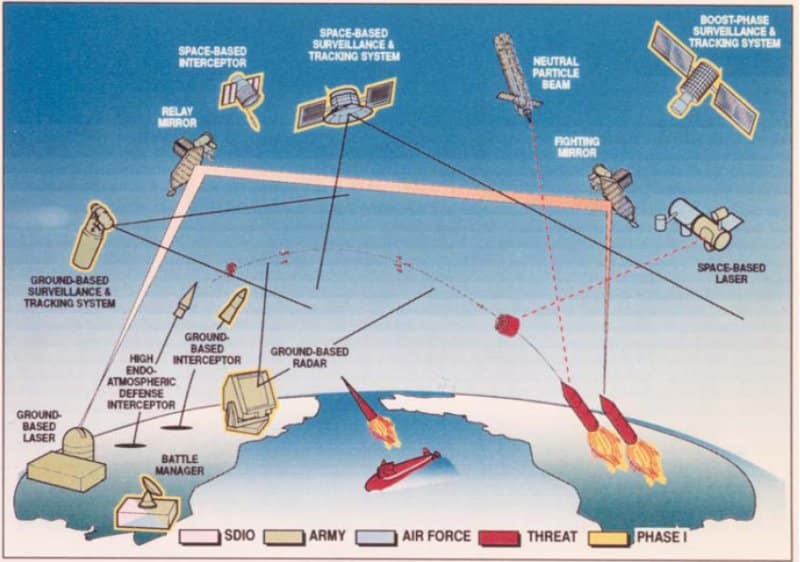by MELVIN GOODMAN
COUNTERPUNCH.ORG
Last month, the mainstream media endorsed the Pentagon’s description of a collision between an American interceptor rocket and a mock intercontinental ballistic missile over the Pacific Ocean as the “first successful test of whether it could shoot down a North Korean warhead racing toward the United States.” Nonsense!
The reality of anti-missile defense, whether called anti-ballistic missiles, “Star Wars,” or today’s National Missile Defense is—in Yogi Berra’s ironic words—a continuing story of “deja vu all over again.” For the past sixty years, an alliance of weapons laboratories and defense contractors have exaggerated the military threat that these systems are supposed to meet as well as the potential for the success of these systems.
President Eisenhower began the search for a defense against ICBMs in the 1950s when he authorized the operational development of a nuclear-tipped interceptor missile. President Nixon moved from protecting cities to protecting military sites, and the Senate approved the deployment of a SAFEGUARD anti-ballistic missile system to protect Minuteman missiles in North Dakota. Hundreds of billions of dollars have been spent on these projects.
In 1981, President Reagan launched the biggest peacetime military buildup in history in order to close
a non-existent gap i n both nuclear and conventional arms with the Soviet Union. CIA director William Casey and deputy director Robert Gates falsified intelligence to justify the buildup, but an economic downturn and a growing nuclear freeze movement led to pressures against increased defense spending. President Reagan’s response was the Strategic Defense Initiative or “Star Wars” to change his image from a warmonger to a man of piece and to gain addition military appropriations.
n both nuclear and conventional arms with the Soviet Union. CIA director William Casey and deputy director Robert Gates falsified intelligence to justify the buildup, but an economic downturn and a growing nuclear freeze movement led to pressures against increased defense spending. President Reagan’s response was the Strategic Defense Initiative or “Star Wars” to change his image from a warmonger to a man of piece and to gain addition military appropriations.
Secretary of State George Shultz, unlike other members of Reagan’s national security team, was interested in a genuine detente with the Soviet Union and did his best to tone down the “Star Wars” campaign. In private, he went even further, calling Reagan’s science adviser George Keyworth a “lunatic” for suggesting that the technology existed to create a genuine national missile defense (NMD). The arguments against “Star Wars” that Shultz raised thirty years ago were spot on, and should remind us today that the idea of such a defense remains an illusion.
Thanks to Presidents George W. Bush and Barack Obama, we now have so-called NMD in California and Alaska, and key military advisers and their congressional allies are calling for an expanded system on the East Coast. President Bush is particularly responsible because he abrogated the 1972 Anti-Ballistic Missile Treaty, the cornerstone of strategic deterrence, and began a campaign against multilateralism that the Trump administration is waging aggressively. In his memoir, former secretary of defense Donald Rumsfeld fatuously argued that the ABM Treaty was of “dubious legality” because it was negotiated with a Soviet Union that no longer existed.
North Korea has been far more aggressive in testing its missile program in recent months, launching a dozen missiles since the first of the year compared with the 16 tests that took place during the 17-year reign of Kim Jong Un’s father. Nevertheless, Pyongyang has not demonstrated a missile that could reach the continental United States or the ability to shrink a nuclear warhead to fit atop an ICBM and survive the stresses of re-entering the atmosphere. Since 1999, the CIA has regularly predicted that North Korea would have ICBMs to deploy against the United States. Secretary of Defense William Cohen cited the 1999 assessment in calling for deployment of national missile defense.
At the same time, the United States has not demonstrated a defensive system that can deal with unsophisticated countermeasures, including the ability to distinguish between genuine and fake warheads. U.S. defensive systems could be evaded with short-range ballistic and cruise missiles, and have no value against munitions designed to disperse chemical and biological agents. Since a national missile defense could never be tested in battlefield conditions, any shortcomings would not be apparent until it was too late. U.S. strategic defenses are already undercutting U.S. efforts to counter the proliferation of strategic offensive weaponry, thus jeopardizing strategic stability.
 What the United States has failed to do is to test North Korea’s interest in actual negotiations to place limits on Pyongyang’s missile program. The United States has genuine leverage in this regard because of Pyongyang’s interest in a peace treaty to end a Korean War that was waged 65 years ago, and to ensure that the United States doesn’t return nuclear weapons to South Korea. Pyongyang would also like to see some limits on extensive U.S.-South Korean military exercises, which are responsible for increased tensions in the region. Washington regularly ignores Beijing’s suggestion of a trade-off between limits on North Korean missile testing for greater restraint in U.S.-South Korean joint military exercises.
What the United States has failed to do is to test North Korea’s interest in actual negotiations to place limits on Pyongyang’s missile program. The United States has genuine leverage in this regard because of Pyongyang’s interest in a peace treaty to end a Korean War that was waged 65 years ago, and to ensure that the United States doesn’t return nuclear weapons to South Korea. Pyongyang would also like to see some limits on extensive U.S.-South Korean military exercises, which are responsible for increased tensions in the region. Washington regularly ignores Beijing’s suggestion of a trade-off between limits on North Korean missile testing for greater restraint in U.S.-South Korean joint military exercises.
 Unfortunately, the first five months of the Trump administration have clarified that Washington is far more interested in unilateralism than in multilateralism, and has not looked for ways to bargain with either Pyongyang or Moscow toward limiting missile testing or reducing strategic inventories, respectively. In the past twenty years, we have witnessed the dissolution of the Arms Control and Disarmament Agency, the abrogation of the ABM Treaty, and the nonsensical deployment of a national missile defense. There is no reason to believe that the Trump administration, dominated by general officers and an incompetent secretary of state, has the sagacity to pursue statesmanship. The myth of American exceptionalism will continue to dominate American strategy.
Unfortunately, the first five months of the Trump administration have clarified that Washington is far more interested in unilateralism than in multilateralism, and has not looked for ways to bargain with either Pyongyang or Moscow toward limiting missile testing or reducing strategic inventories, respectively. In the past twenty years, we have witnessed the dissolution of the Arms Control and Disarmament Agency, the abrogation of the ABM Treaty, and the nonsensical deployment of a national missile defense. There is no reason to believe that the Trump administration, dominated by general officers and an incompetent secretary of state, has the sagacity to pursue statesmanship. The myth of American exceptionalism will continue to dominate American strategy.
 The reality of anti-missile defense, whether called anti-ballistic missiles, “Star Wars,” or today’s National Missile Defense is—in Yogi Berra’s ironic words—a continuing story of “deja vu all over again.” For the past sixty years, an alliance of weapons laboratories and defense contractors have exaggerated the military threat that these systems are supposed to meet as well as the potential for the success of these systems.
The reality of anti-missile defense, whether called anti-ballistic missiles, “Star Wars,” or today’s National Missile Defense is—in Yogi Berra’s ironic words—a continuing story of “deja vu all over again.” For the past sixty years, an alliance of weapons laboratories and defense contractors have exaggerated the military threat that these systems are supposed to meet as well as the potential for the success of these systems.
![]()
[premium_newsticker id=”154171″]






